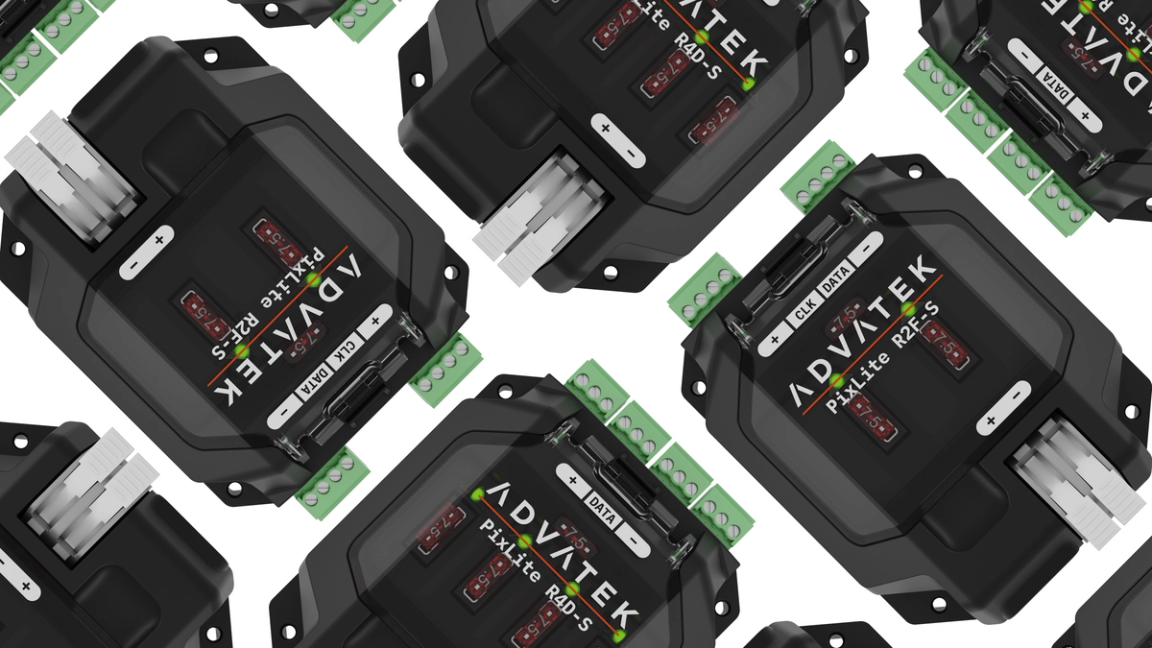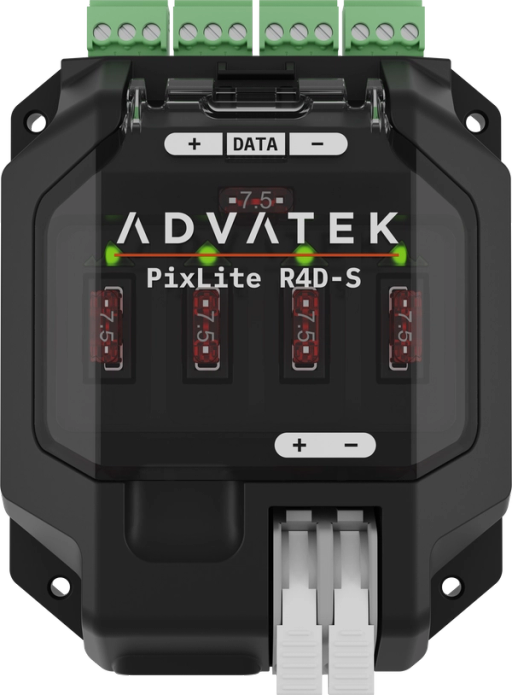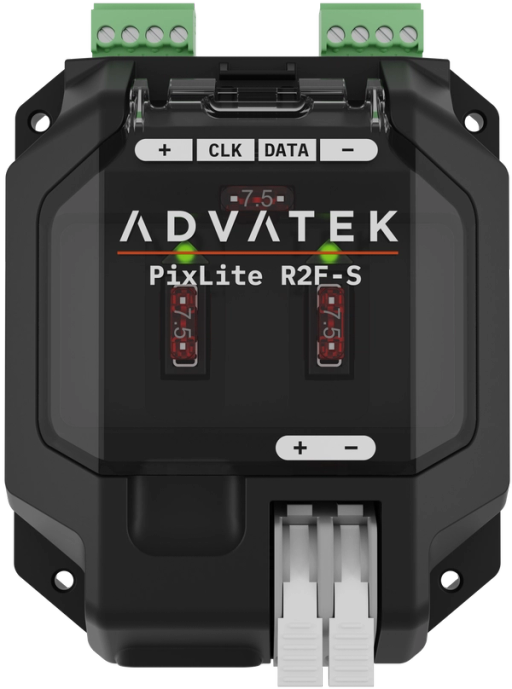
PixLite® R4D-S, PixLite® R1F-S or PixLite® R2F-S - What's the Difference?
If you’re a keen lighting designer or technician, you will have heard the news of the latest line of products to share the name of Advatek PixLite®. The PixLite T8-S Mk3 and the PixLite® T16X-Mk3 provide long-range control of 96 DMX universes. These transmitters are designed to work with long-range pixel receivers, completing the system with three options: the PixLite R2F-S , the PixLite® R1F-S and the PixLite R4D-S. Each receiver offers unique features and compatibility, ensuring flexibility for different lighting installations. So, which one do you need? These questions will help you find the answer.

PixLite® R4D-S
Designed to bring sizable projects to life, the R4D-S receiver works together with the T8-S Mk3 transmitter to drive up to 2,040 RGB pixels for larger-scale installations.
R4, R2, R1 - Does either compromise on features?
The PixLite® R2F-S and PixLite R4D-S are built upon the same hardware foundation, capable of translating several universes of differential data from a long-range pixel controller to RGB(W) pixels. This is enough to control 2,040 RGB pixels or 1,536 RGBW pixels per receiver unit.
These long-range pixel receivers achieve the same user experience, featuring intuitive fuse indicator LEDs, flip-lid access for quick fuse replacement, and the ability to disable indicator LEDs if desired.
The PixLite® R1F-S brings some interesting new innovations, including a wider voltage range, a higher current capacity, and it also comes in a smaller form factor, perfect for installations with space-constraints.
Additionally, these three units can be mounted on a wall or DIN rail and are designed for tight installation spaces. They come in a custom-molded, slimline plastic enclosure, offering industrial-grade fault protection, as well as CE and FCC compliance for professional installations.
PixLite® R4D-S, R2F-S and R1F-S - What's Really the Difference?
The three long-range pixel receivers offer specific functionality, depending on the pixel type and the number of pixels required for your application.
The PixLite® R2F-S is designed for both clocked and data-only pixels, providing two full outputs that each include power, clock and data.
The PixLite® R1F-S supports a single pixel run of either clocked or data-only pixels, making it a more compact option for applications where only one data output is needed. It offers higher voltage flexibility (5-48V) and a 10A pass-through current, making it ideal for powering a single high-load pixel run.
The PixLite® R4D-S is built specifically for Expanded Mode applications, where clock lines are converted into additional data lines. This receiver offers four data-only outputs, each operating at 7.5A per output. However, each output can only drive half as many pixels, so system design should account for this.
The main difference between these receivers lies in their signal handling and output capabilities, and there are five pairings that can be achieved.

PixLite R4D-S vs R2F-S
Do I Need a Clock?
Some pixel types require a clock signal, while others do not. If your pixels require four wires (power, data, clock, ground), you will need a receiver that supports clocked pixels. The R2F-S and R1F-S are the two receivers capable of handling clock signals.
If your setup exclusively uses data-only pixels, then the R4D-S is a suitable option, particularly if you plan to run Expanded Mode on your transmitter.
If you need flexibility to support both clocked and data-only pixels in different installations, the R2F-S or R1F-S will be the best choices.
Do I Want to Use Expanded Mode?
Expanded Mode allows for additional pixel runs by repurposing clock lines as extra data lines, effectively doubling the number of outputs at the cost of halving pixels per output. If Expanded Mode is enabled, then data-only pixels are to be used.
If you do not need Expanded Mode and require clocked pixels, the R2F-S or R1F-S is required.
If you are using Expanded Mode, the R4D-S is the recommended option.
What About Power?
Each receiver provides dedicated power outputs, but with different power-handling capacities:
R1F-S: Supports 10A total (one output).
R2F-S: Supports 7.5A per output, 15A total.
R4D-S: Supports 7.5A per output, 30A total.
The R4D-S offers the highest total output, while the R1F-S provides higher current for a single run.
The R1 can be used with a T16 in expanded mode, allowing for two runs of pixels. In this case, each run shares the 10A total current.
How many will I need?
A PixLite® T8 system can connect up to 8 long-range receivers, while a PixLite® T16 can connect up to 16 long-range receivers. Each receiver can be located up to 300m away from the transmitter using standard Cat-5/6 cabling.
The number of receivers needed depends on pixel density, layout, and voltage requirements. Many installations centralize transmitters in a rack while placing receivers closer to the pixel locations. A good starting point is one transmitter with 8 or 16 receivers, but the final count depends on system complexity.
Conclusion
The PixLite R2F-S, R1F-S, and R4D-S each provide unique advantages for different long-range pixel control applications. The R2F-S offers two outputs with clock support, the R1F-S provides a single high-power output, and the R4D-S is optimized for Expanded Mode with four data-only outputs. By understanding these differences, you can confidently select the right receiver for your installation.
For more details, refer to the PixLite product pages or contact Advatek Lighting for expert recommendations.

